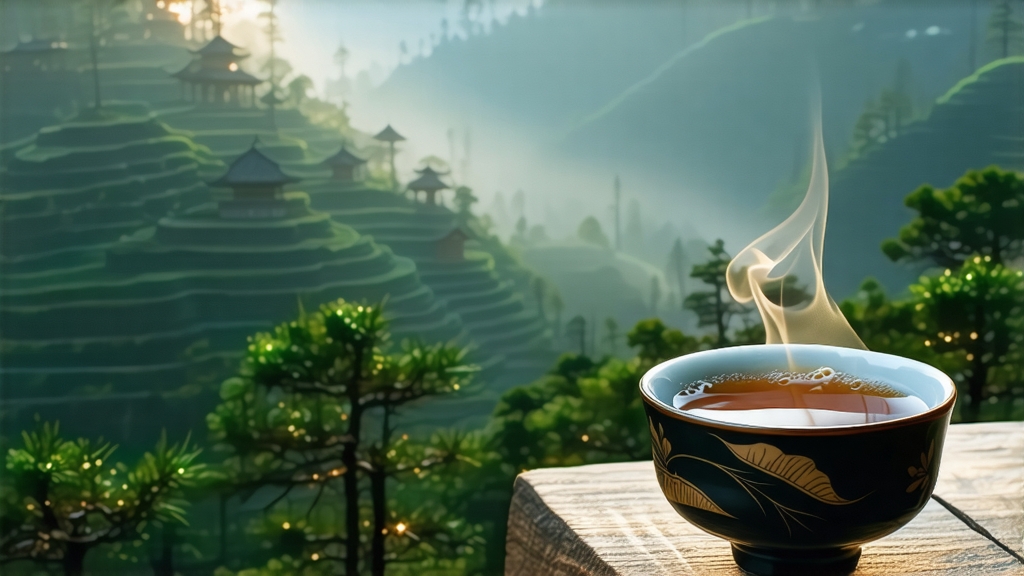
Long before English merchants coined the term “black tea,” the charcoal-dark leaves that filled their Canton chests were known in the Minbei dialect as zhengshan xiaozhong—literally “small-leaf from the original mountain.” Today the world calls it Lapsang Souchong, and every sip still carries the perfume of the Wuyi cliffs where the story began.
1. Birthplace and myth
Rising from the banks of the Chongyang Brook, the Wuyi massif is a UNESCO dual heritage site whose vertical ravines trap morning mists the way a gaiwan traps aroma. Local lore places the birth of Lapsang Souchong in 1568, when a passing army commandeered a tea farm near Tongmu village. To dry the leaves quickly before the soldiers returned, farmers spread them over pine fires. The accidental smoke infusion proved irresistible to the Dutch traders who first carried the tea to Europe, and by 1604 it was selling in Amsterdam apothecaries for more than the price of silver. Thus the world’s earliest fully oxidized tea left China as “bohea,” a corruption of the Wuyi range’s name, and returned decades later under the anglicized label “black tea.”
2. Terroir and cultivar
Authentic Lapsang Souchong can only be produced inside the 565 km² core protection zone of the Wuyi National Park. The soil is a coarse, mineral-rich laterite weathered from tuffaceous rock; it drains instantly yet holds warmth, forcing the tea bushes—predominantly the small-leaf Caixia and Wuyi Qizhong cultivars—to send roots two metres down in search of moisture. The diurnal swing can exceed 15 °C, concentrating sugars and volatile aromatics. Because pesticides are forbidden inside the reserve, the ecosystem remains intact: spiders outnumber farm workers, and the same pine species (Pinus massoniana) used for smoking grows wild on the ridges, ensuring a closed aromatic loop between forest and factory.
3. Two styles: smoke and no smoke
International consumers usually meet the smoke-forward version, yet Tongmu locals themselves drink the unsmoked “xiao zhong” prized for its longan-sweet finish. Both styles share the same plucking standard: one bud, two or three leaves picked when the bud still reclines like a folded dagger. After withering on bamboo racks above gentle charcoal embers, the leaves are rolled by hand until the cell rupture rate reaches 85 %, initiating oxidation. For smoked Lapsang, the critical stage comes next: the semi-dry leaves are spread 3 cm deep on wire mesh suspended inside a brick kiln where fresh pine logs smoulder at 80–90 °C. Smoke particles laden with guaiacol and syringol permeate the leaf for two to three hours until moisture drops to 20 %. The unsmoked style bypasses the pine room and moves directly to hot-air drying, allowing honeyed, lychee-like notes to dominate. Both versions are then charcoal-baked three times over the following month, each bake lowering residual moisture by 1–2 % while deepening maltiness.
4. Craft signs and grades
Look for glossy, jet-black leaves that are slim and slightly curved like willow twigs; the presence of golden tips indicates a higher grade called “jinjun mei,” a 2005 offshoot that restricts plucking to buds alone. When smoked Lapsang is genuine, the aroma is clean campfire, not creosote; if you smell kerosene, the leaves were rushed over rubber-wood flames. The cup should glow amber under natural light, with a reddish rim that the Chinese call “golden circle.”
5. Brewing: gongfu versus Western
Gongfu style best reveals the tea’s evolving layers. Use a 120 ml porcelain gaiwan, 5 g of leaf, and water just off a rolling boil (98 °C). Rinse for two seconds to wake the leaf, discard, then infuse 5 s, 10 s, 15 s, adding five seconds each steep thereafter. The first infusions deliver pine and longan; by the fifth, cocoa and roasted sweet potato emerge; after the tenth, a cooling camphor sensation lingers on the palate. For a Western pot, 2.5 g per 250 ml, three minutes at 95 °C yields a single,